|
SETMA’s Weight Management Program is built on the AMA’s Adult Weight Management Program which was published in February, 2004. It is premised on the proposition that excess weight and/or frank obesity is not simply coincidental with virtually every disease which we treat but is either contributory and/or directly causative of those conditions including hypertension, congestive heart failure, diabetes, metabolic syndrome, hyperlipidemia, coronary artery disease, and a number of types of cancer, among many others.
SETMA’s weight management program is designed to make it simple for health care providers to determine and to document whether or not patients are qualified for treatment with medication or surgery, based on sound scientific evidence. This tutorial will help all providers learn to utilize this suite of templates either for intensive weight management of a patient, or for giving the patient a weight-management assessment, and/or to help a patient understand why they do, or do not qualify for pharmaceutical and/or surgical treatment of their weight.
The weight management assessment is a part of SETMA’s LESS Initiative which is utilized with every patient we see.
The Weight Management templates can be accessed from:
AAA Home

LESS Initiative
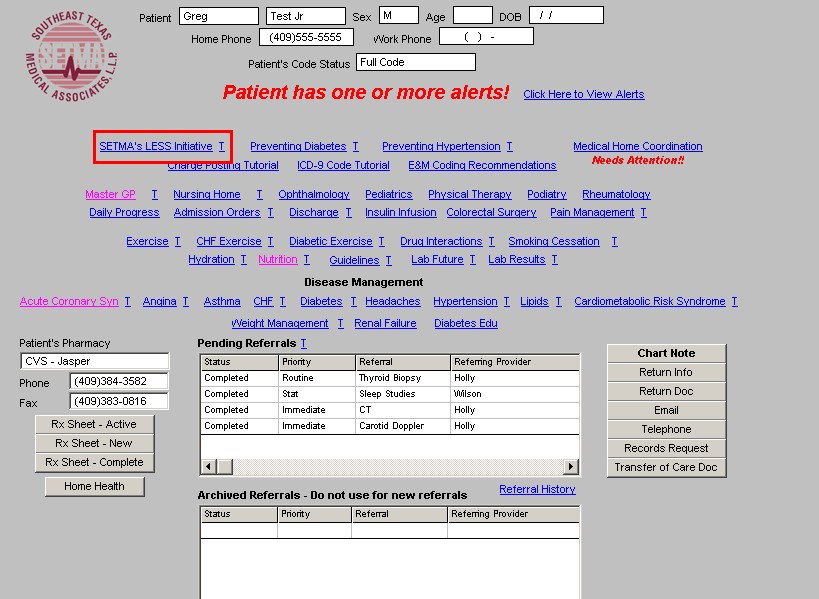
Main Tool Bar
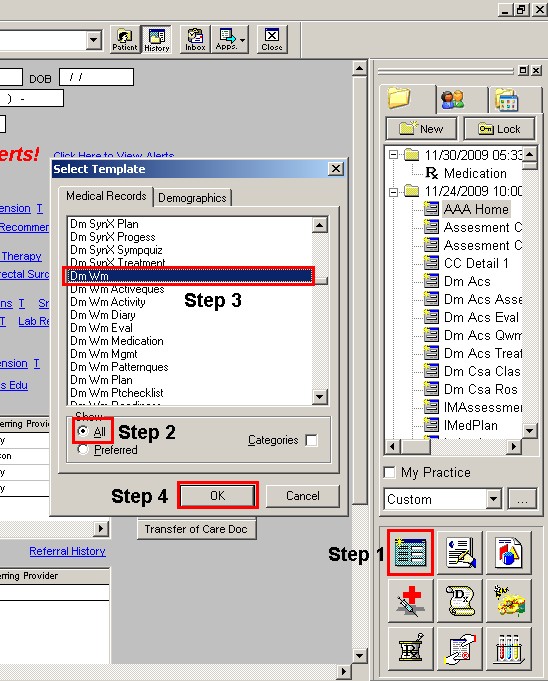
When the Template button is clicked you will be presented with the preference list.
- If the Weight Management (Dm Wm) template is listed as one of your preferences, select it.
- If it is not one of your preferences, select the All radio button and scroll down until you find it in the list. Then you may select the template by either double-clicking on the name or single click on the name (so that it is highlighted in blue) and then click the OK button.
NOTE: For more on how to set up your preferences, Click Here
It is also accessible from several other disease management suites of templates.
The Suite consists of 8 templates which are unique to Weight Management. They are:
- Physician Role
- Evaluation
- Readiness
- Diet Management
- Physical Activity
- Medication
- Surgery
- Follow-up

As with other disease management suites, it is possible to utilize templates from the Master GP Suite of Templates by checking the radial button beside General on the Weight Management Master Template. This displays the following templates from the Master GP Suite:
- Chief/Chronic
- HPI
- Histories
- System Review
- Physical Exam
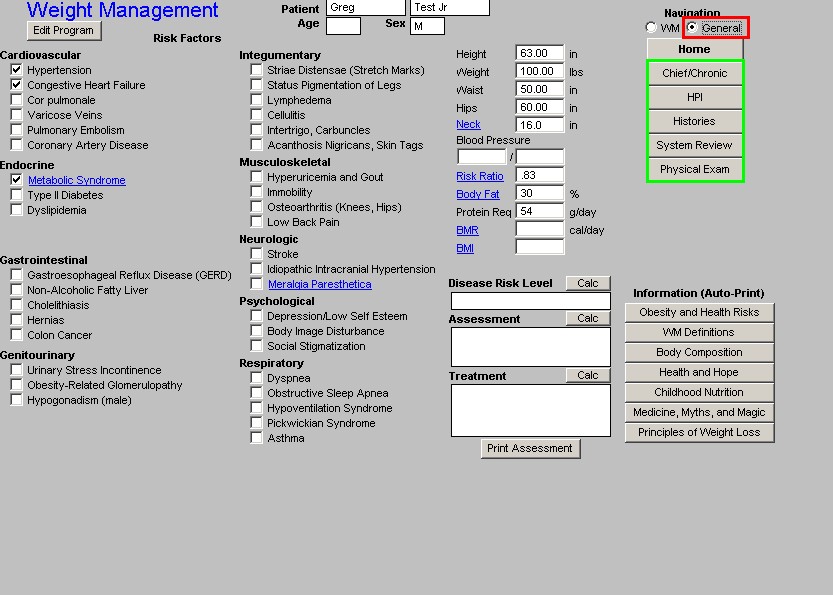
To display the Weight Management Templates, check the radial button next to WM at the top of the fourth column on the Weight Management Master template.
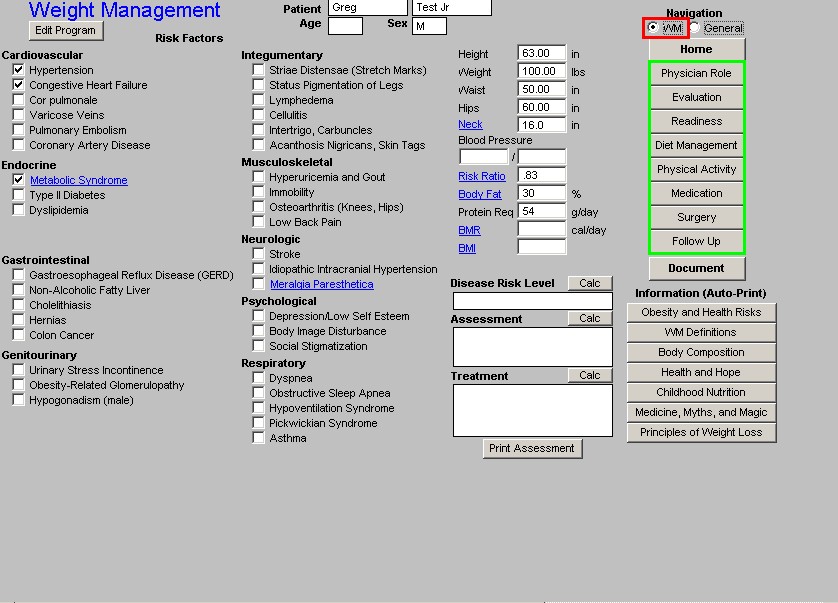
Weight Management Master Template
Once this template has been completed for the first time, subsequent use of it takes only a few seconds. However, the information contained in it has had a significant impact upon patient’s realization of their need to lose weight.
At the top of the template, the following information appears:
- Title
- Patient’s name, age, sex
- Edit Program Button
The Edit Program button allows you to reset the Program Start Weigh and the Patient’s Target Weight.
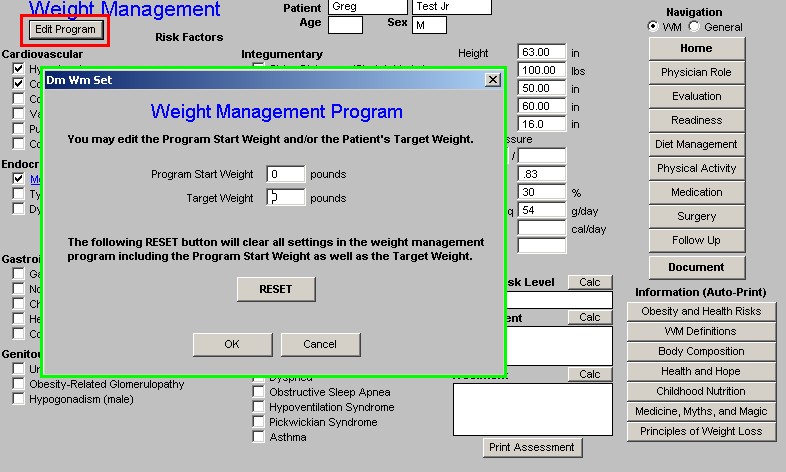
Typically, the Program Start Weight will be the weight obtained during the patient encounter when the Weight Management Suite was first accessed. The Patient’s Target Weight will be the patient’s ideal body weight calculated by the weight management assessment. It is the weight where there is no longer a health risk from the patient’s weight. For a female that will be a BMI of 30 and for a male a BMI of 25.
There are circumstances where the Program Start Weight may need to be changed, as in the case of a patient who was seen several years before and the Weight Management Program Start Weight was established. If the patient did not continue the program at that time but now is beginning the program again, it would be appropriate to change the Program Start Weight.
There are also circumstances where the Patient’s Target Weight would not be defined appropriately by the algorithm built into SETMA’s program. For instance, if there is a disconnect between the BMI and body fat due to muscle mass, it might be appropriate to set a Patient’s Target Weight higher than that calculated.
To change the Program Start Weight and/or the Patient’s Target Weight, simply click the Edit Program button and manually enter the appropriate Start Weight and Target Weight numbers for this patient.
Then click the RESET button and the weight’s you put into the boxes on the pop-up will now become the reference numbers for the Weight Management Program for this patient.
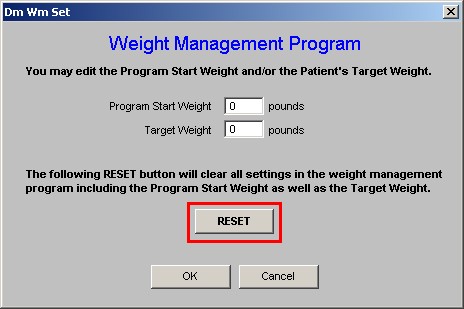
After following the above directions, click on OK and you will be returned to the Weight Management Master Template. The Master Template is organized into four columns.
Column 1
This column displays four categories of Risk Factors which increase the cardiovascular and/or health risk associated with excess weight. The categories are:
- Cardiovascular
- Endocrine
- Gastrointestinal
- Genitourinary
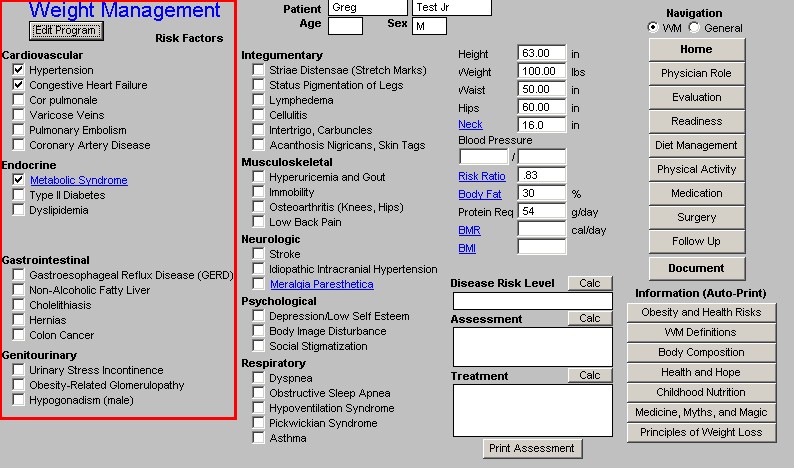
Column 2
There are five categories of Risk Factors which increase the cardiovascular and/or health risk associated with excess weight; they are:
- Integumentary
- Musculoskeletal
- Neurologic
- Psychological
- Respiratory
Within each of the above 9 categories are specific conditions which increase the patient’s health risk due to being overweight or obese. Some of these conditions, which are related to data captured elsewhere in the EMR, are automatically noted, others require you to manually note them. Once noted, the condition remains marked until manually unmarked.

Column 3
Vital Signs and Body Composition Measurements are displayed here:
- Height
- Weight Waist
- Hips
- Neck – the neck size is very important, as a large neck significantly increases a patient’s risk of sleep apnea. The help button attached to this element of body composition gives details on this risk.
- Blood Pressure
- Risk Ratio
- Body Fat – the body fat is a critical element of the computations which are automatically performed by this program. In addition, body-fat-percent values have a dramatic impact on patient’s perception of their body composition, which is a key element to their readiness for change.
- Protein Requirement – a patient’s daily protein requirement is important in that any dietary program needs to maintain the patient’s protein requirement so as to minimize the metabolism of the patient’s own muscle mass.
- BMR
- BMI – attached to BMI is a table entitled “Classification of Overweight and Obese by BMI, Waist Circumference and Associated Disease Risks.” This is the information from which the Class of Obesity and the Disease Risk of obesity is determined below.
These vital signs and body composition measurements are automatically posted from the Master GP Nursing Template
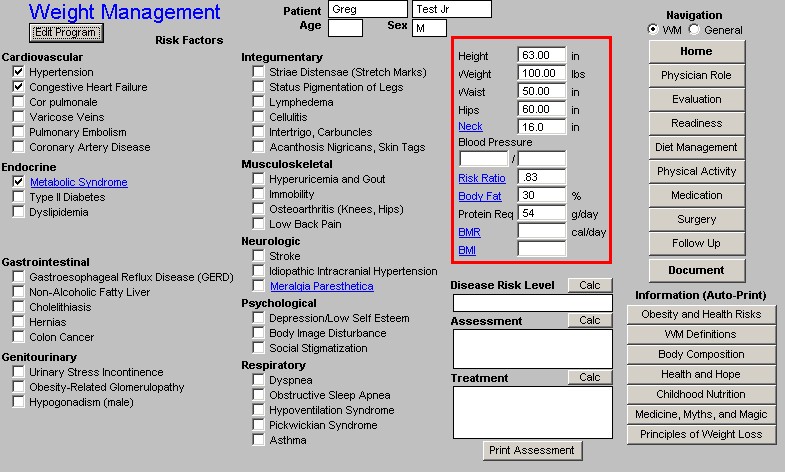
Beneath the BMI, the Class of Obesity or Overweight will appear automatically. This is calculated on the basis of the algorithm which is displayed when you click on the BMI link.
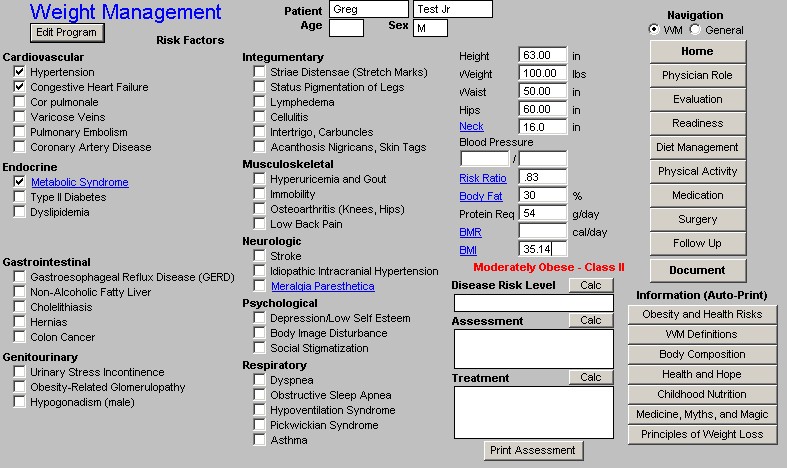
The following three buttons launch computations based on the above collected data. The computations are initiated by clicking on the “Calc,” which stands for “calculate,” button beside each of the three boxes:
- Disease Risk Level – Calc – This is determined from the algorithm which is attached to BMI above.
- Assessment – Calc – This is determined based on the BMI.
- Treatment – Calc – This is determined based on both the BMI and the Disease Risk Level.
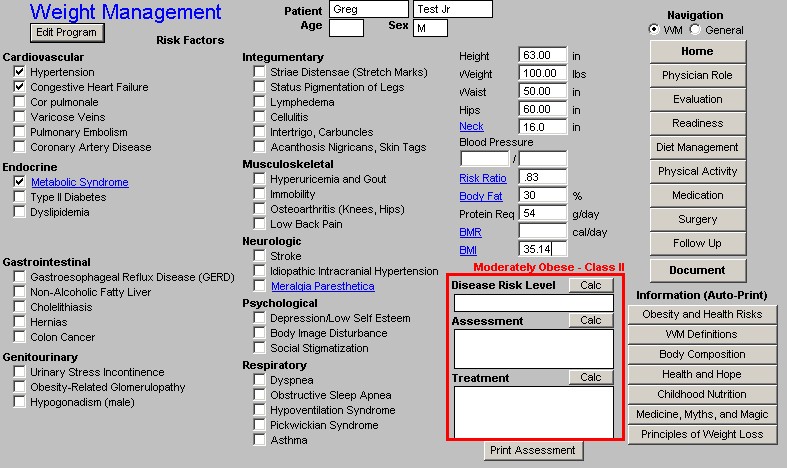
Print Assessment – this button launches the creation of the Weight Management Assessment. This is the one-page summary which is given to patients through SETMA’s LESS Initiative. It contains the following information:
- Identification Information
- BMI, Body Fat Percent and Waist Size
- Class of Obesity and Disease Risk Assessment
- An explanation of BMR and how it can be changed.
- The benefit the patient would receive from a 5 – 10% weight decrease and what that would translate into in pounds lost.
- The amount of weight loss required for weight to cease to be a health hazard.
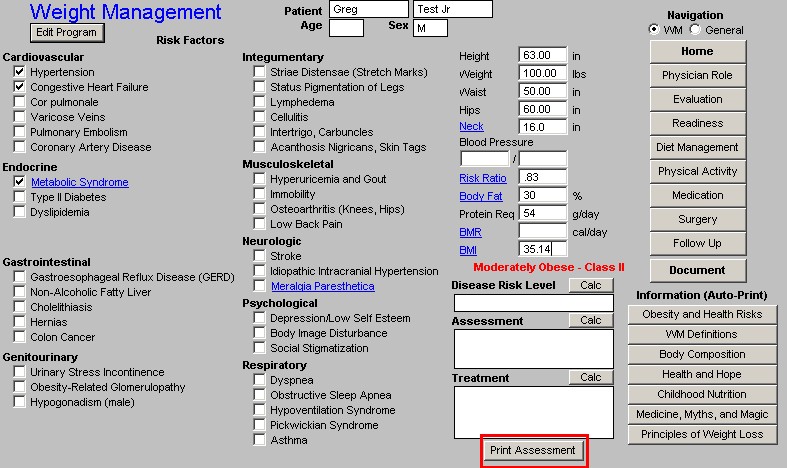
Column 4 –
Navigation – the set of templates which are displayed will depend upon which radial button is checked. (See above)
- Weight Management Specific Templates – WM
- Master GP Templates – General
Information (auto-pint) – this is patient education materials which auto prints when you access them.
- Obesity and Health Risks
- WM Definitions
- Body Composition
- Health and Hope
- Childhood Nutrition
- Medicine, Myths, and Magic
- Principles of Weight Loss
Physician Role Template
This is a quality assessment tool which collects information automatically from the patient encounter. This is a kind of “report card,” where a healthcare provider who is dealing with a patient about weight reduction can determine if he/she is covering the materials determined by experts to be required for effectiveness. That information is:
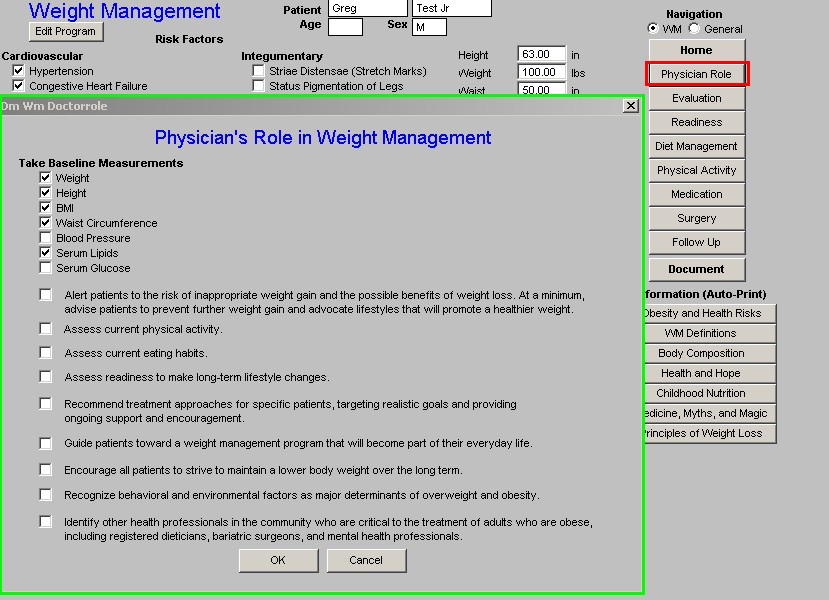
Evaluation Template
This template’s full title is Laboratory and Diagnostic Evaluation of the Obese patient: Based on Presentation of Symptoms, Risk Factors and Index of Suspicion.
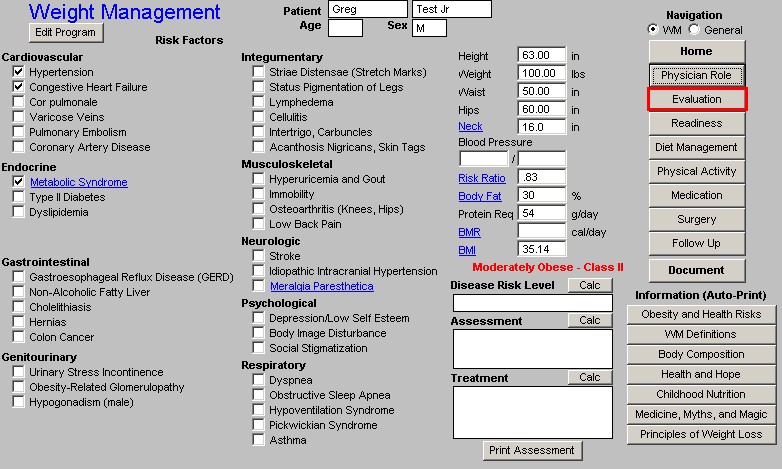
At the top of the template is a button entitled Medications Causing Fat Gain. When depressed, this button displays a list of medications in 6 categories which are associated with body fat weight gain. This list should be reviewed with each patient seeking weight management and who is taking other medications.
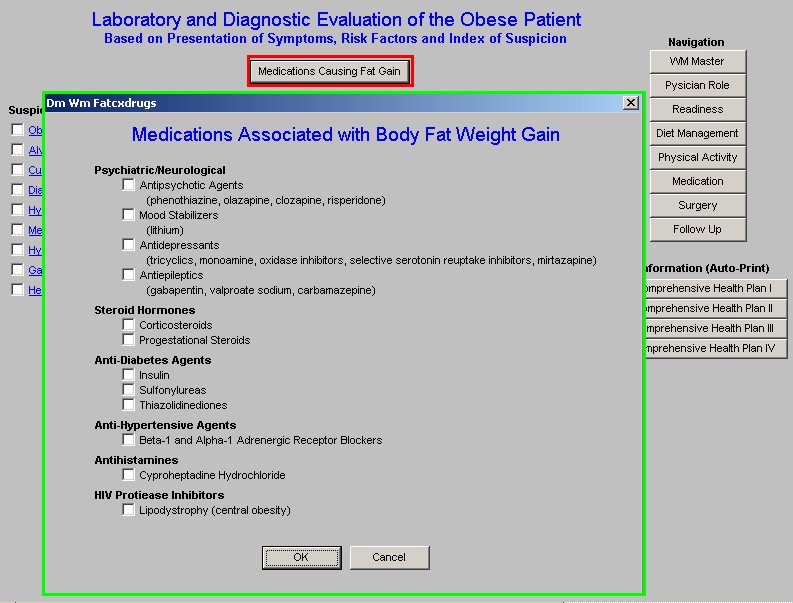
In the right hand column, there are 10 conditions which are common and which are associated with pathophysiology and/or medications which contribute to weight gain.
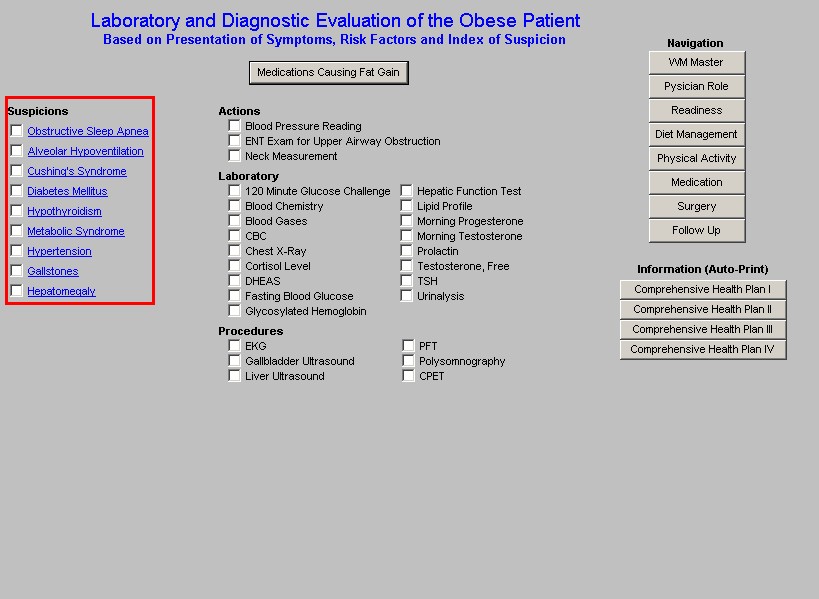
Each of these 10 conditions are also links to information about how to treat the condition. The links on Diabetes, Metabolic Syndrome and Hypertension, take you to the disease management suites associated with those conditions.
Next to the above list of 10 conditions, is a list of Actions, Laboratory and Procedures, which are required in order to evaluate each of these 10 conditions.

When one of the 10 conditions is marked in the box beside it, the Actions, Laboratory or and/or Procedures required to evaluate the presence of this condition will be automatically selected.
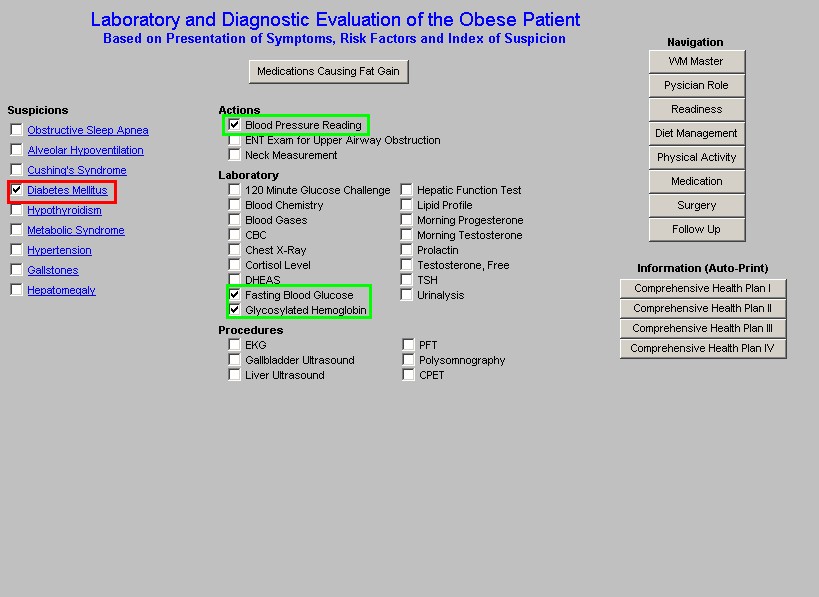
These tests can then be ordered on the charge posting template in the Master GP suite of templates.
In the right hand column of the Evaluation Template, there are:
- Navigation Buttons
- Patient Education Material entitled: Comprehensive Health Plan I-IV.
Readiness Template
This template’s full title is Patient Readiness for Weight Management. This template is important in the patient evaluation for weight management, as it allows the provider to determine where the patient is in the process of change. The intervention recommendations can prompt a healthcare provider to make recommendations and/or to provide information which can move the patient along on the behavior-change continuum to a successful decision to initiate change.
The template is organized into four columns.
Column 1 –
- What is hard about managing your weight? -- This is a list of 9 questions with a comment box.
- How does overweight affect you? – This is a list of 6 questions with a comment box
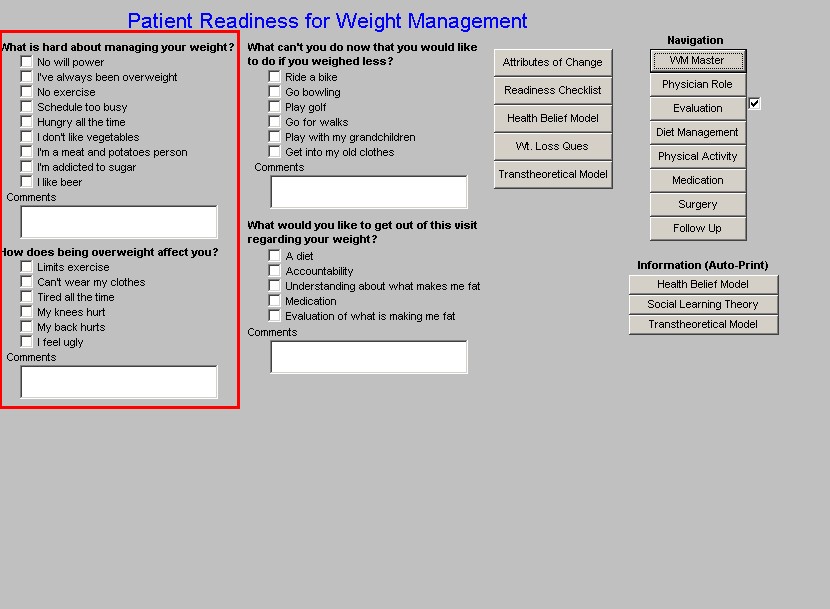
Column 2 –
- What can’t you do now that you would like to do if you weighted less? -- this is a list of 6 questions with a comment box.
- What would you like to get out of this visit regarding your weight? This is a list of 5 options with a comment box.

Column 3 – This is a series of 5 pop-ups entitled:
- Attributes of Change – this identifies 6 attributes of patients ready to change their behavior in order to control their weight. There are boxes available for documenting your review of each of these.
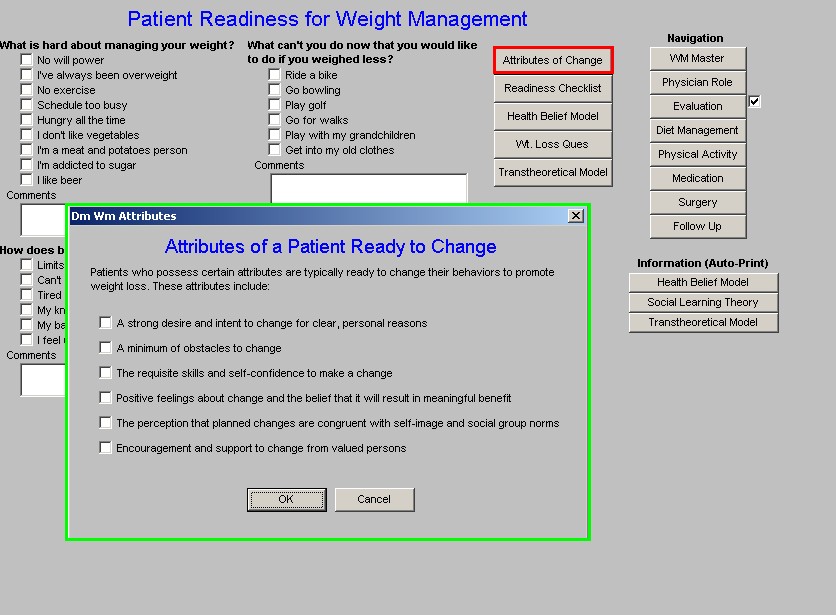
- Patient Readiness Checklist – this is a lengthy checklist for the patient to complete relative to prior efforts to lose weight and present desire to do so. This form can be given to the patient to fill out and the results then can be entered into the computer.
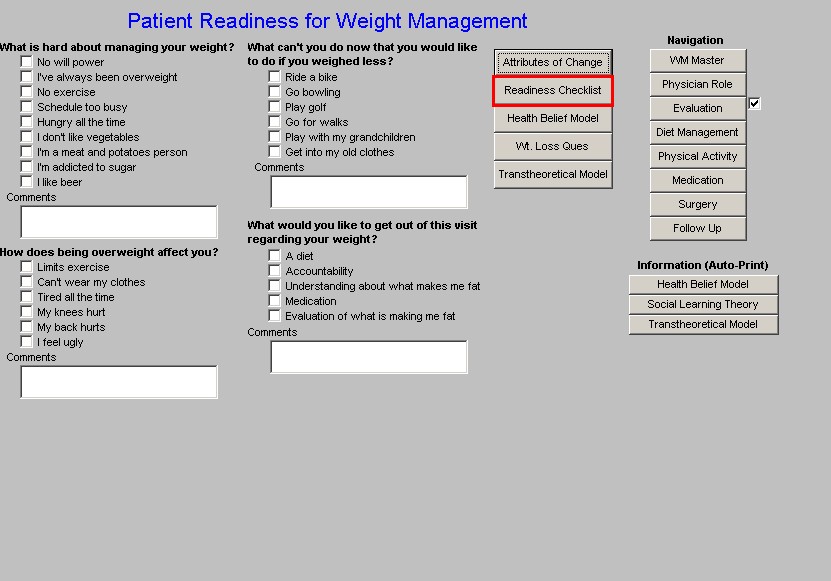
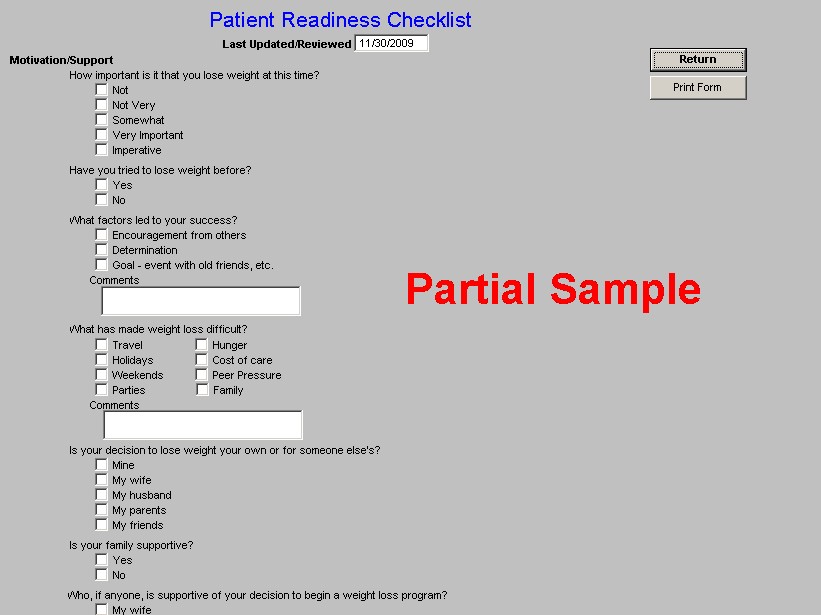
- Health Belief Model --- these are four aspects of this model of behavioral change.
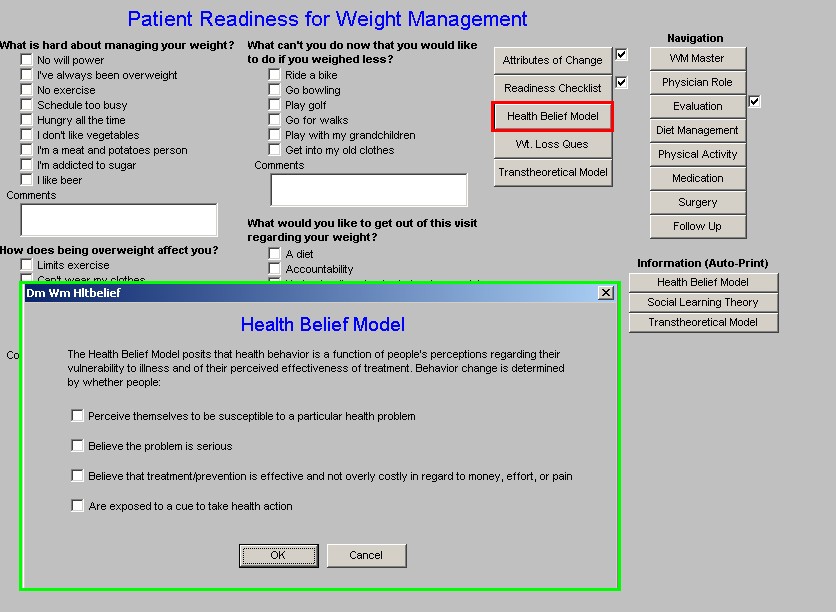
- Weight Loss Questionnaire – this is a lengthy questionnaire which can be printed and given to the patient for completion and then the results can be entered into the computer.
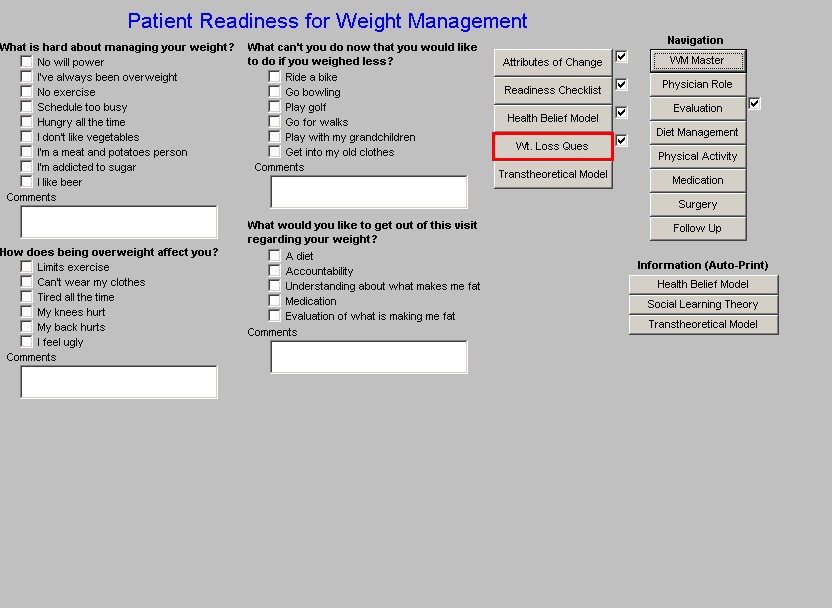
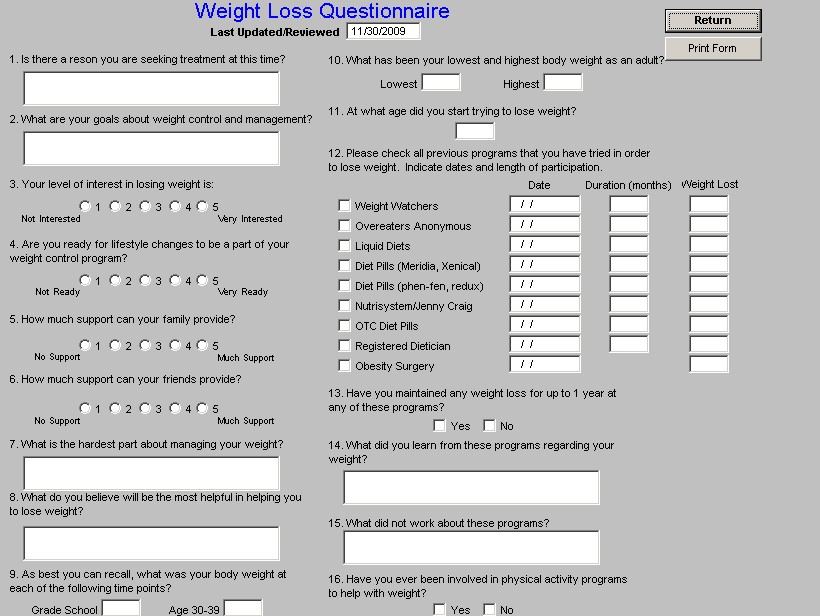
- Transtheoretical Model Stages of Change – this is an electronic version of the well known “stages of change” based on patient characteristics and the appropriate interventions, and the patient’s verbal cues and the appropriate interventions. There is a button on this pop-up which gives the details of the Transtheoretical Model Stages of Change for the provider to review.
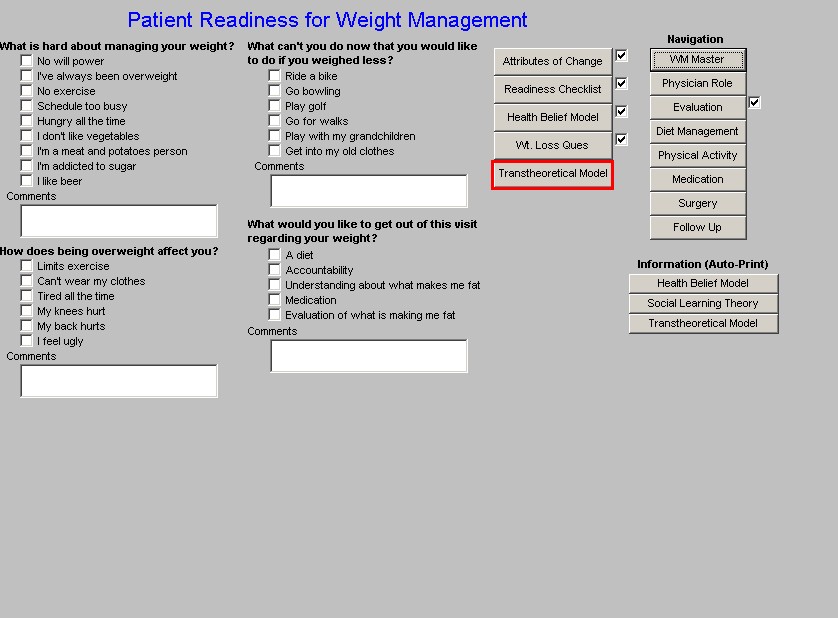
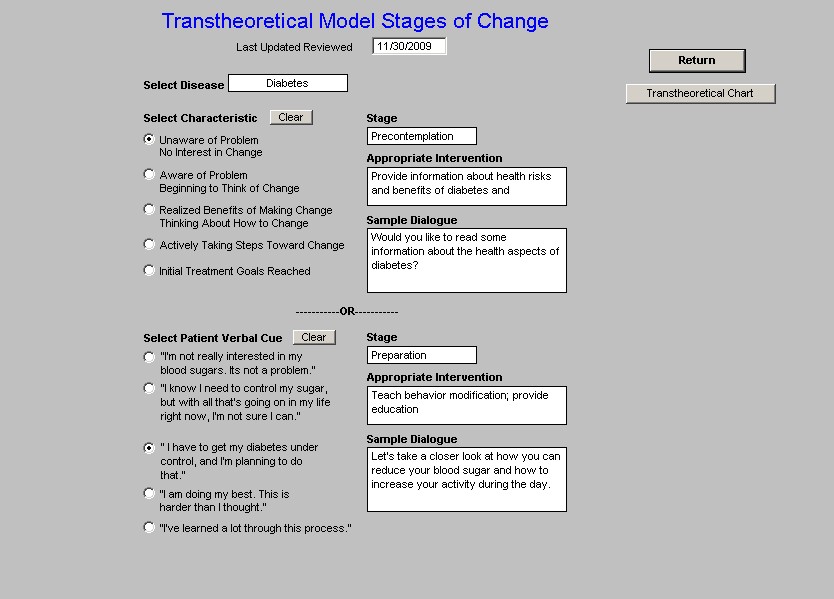
Column 4 –
Navigation Buttons
Three printable documents on the change-of-behavior models used on this template:
- Health Belief Model
- Social Learning Theory
- Transtheoretical Model
These documents auto print when accessed.
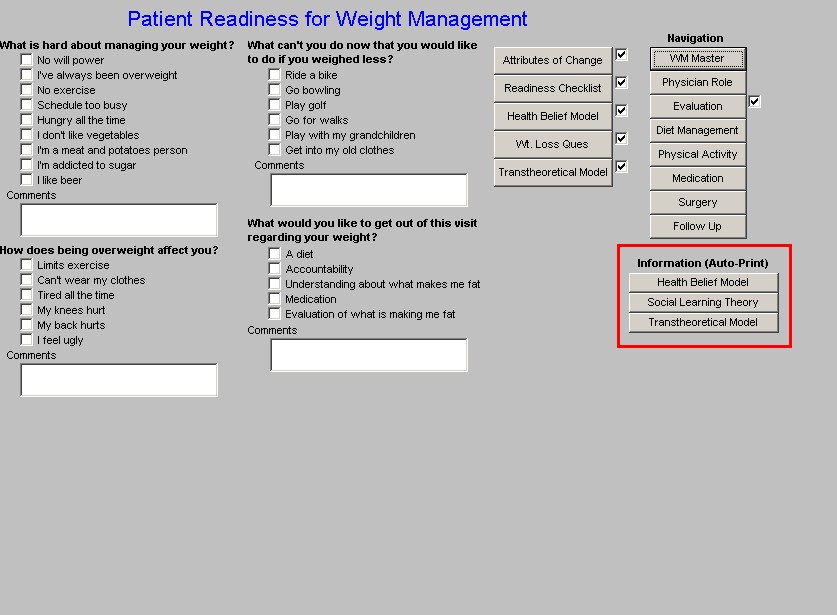
Diet Management Template
This template is organized in three columns:
Column 1 –
- Eating Pattern Questionnaire – this is to be given to the patient to complete and then in-putted to the EMR.

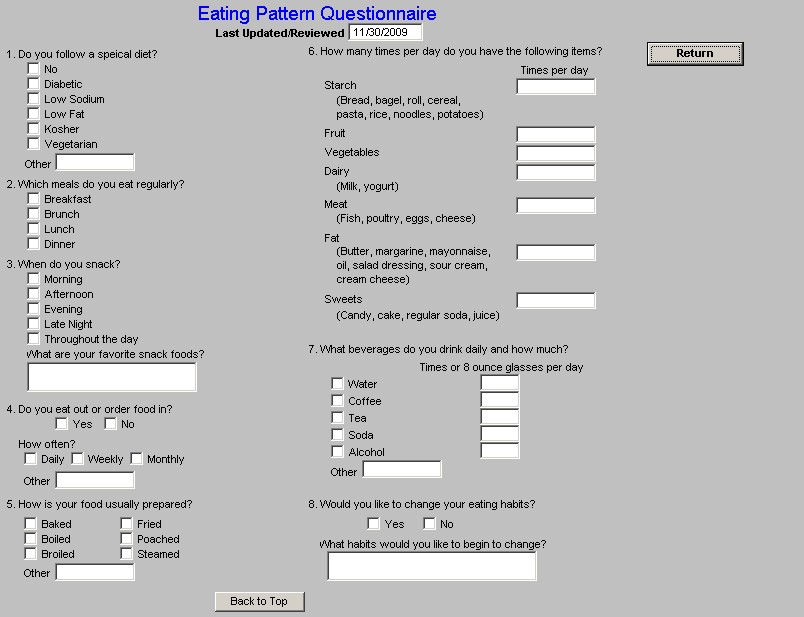
- Diet Recommendations – These are recommendations for a well-balanced diet. These are auto checked and appear automatically on the Weight Management follow-up note
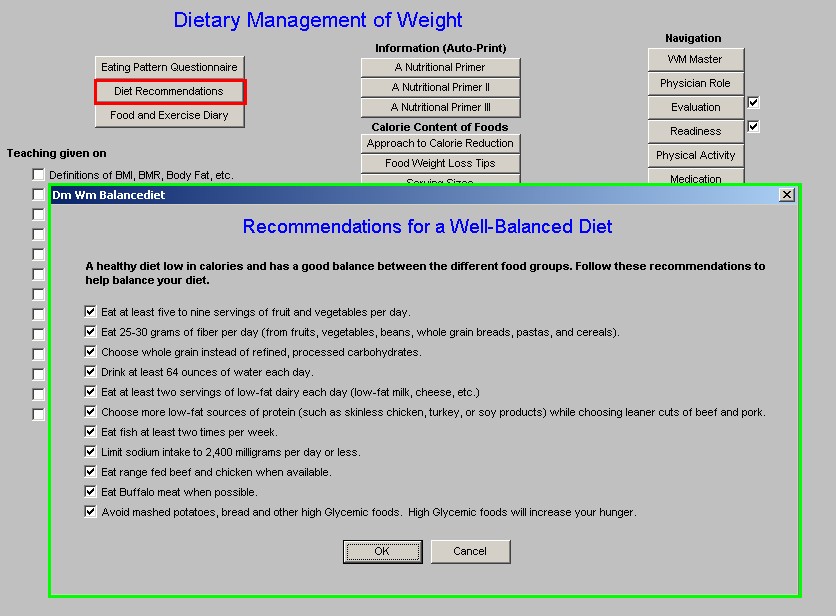
- Food and Exercise Diary – this is a format for a self-guided food and exercise diary.
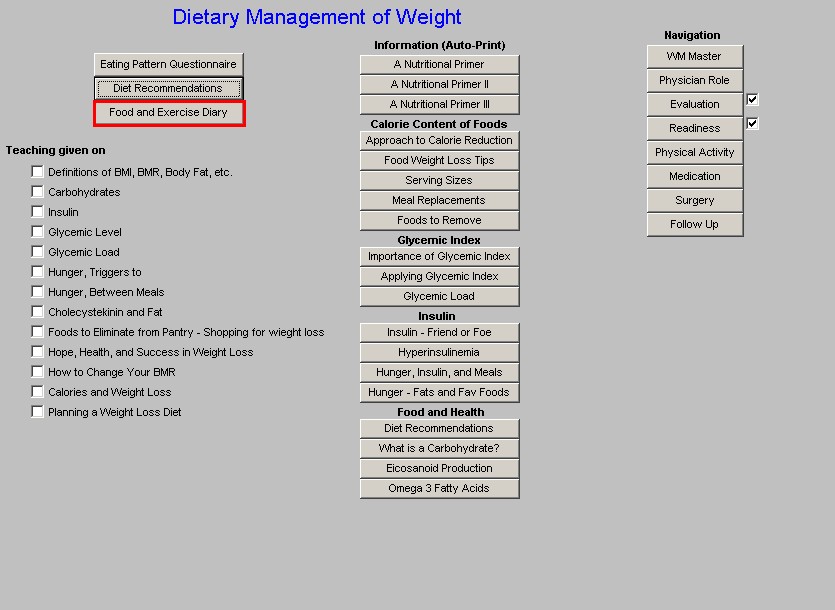
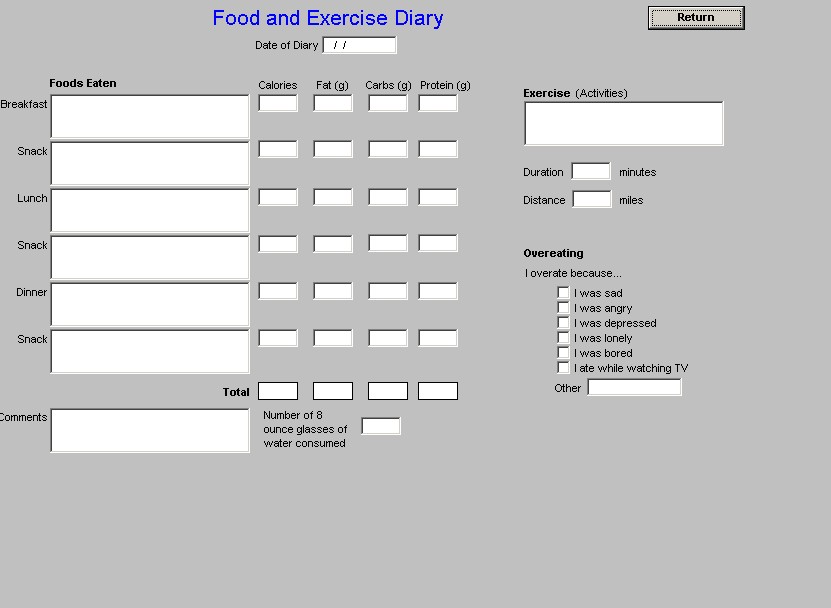
Beneath these three pop-ups are check boxes for the documentation of teaching on a number of subjects. In the next column, there are teaching aides which when given to the patient will automatically document that the patient has been given that education material. The teaching points are:
- Definitions of BMI, BMR, Body Fat
- Carbohydrates
- Insulin
- Glycemic Level
- Glycemic Load
- Hunger, Triggers to
- Hunger, Between Meals
- Cholecystekinin and Fat
- Foods to Eliminate from Pantry – Shopping for weight Loss
- How to change your BMR
- Calories and weight loss
- Planning a Weight Loss Diet
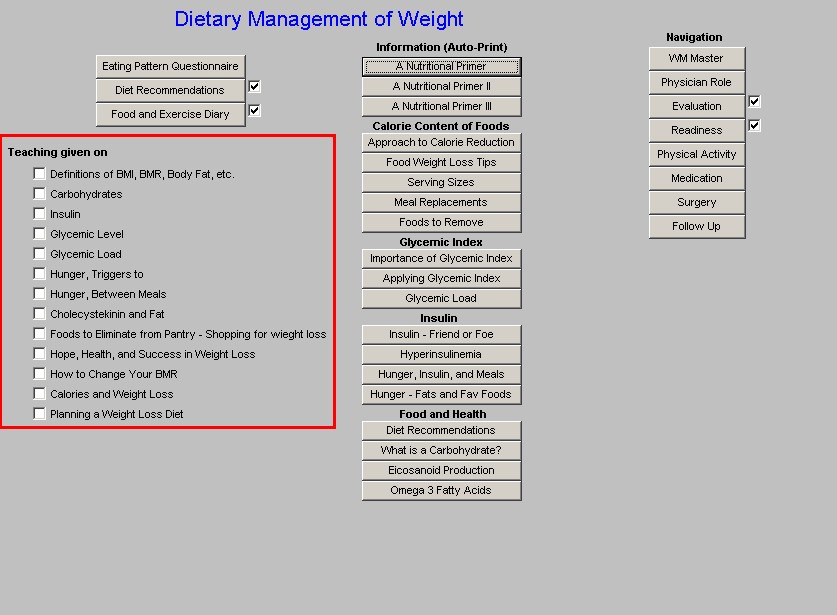
Column 2 –
The following documents are automatically printed when accessed and the fact that you have given his to the patient and reviewed it with them is documented on the “Teaching given on” list above, and on the weight management document and follow-up note.
- A nutritional Primer parts I, II, III
- Approach to Calorie Reduction
- Food Weight Loss Tips
- Serving Sizes
- Meal Replacements
- Foods to Remove
- Importance of Glycemic Index
- Applying Glycemic Index
- Glycemic Load
- Insulin – Friend or Foe
- Hyperinsulinemia
- Hunger, Insulin and Meals
- Hunger – Fats and Favorite Foods
- Diet Recommendations
- What is a carbohydrate?
- Eicosanoid Production
- Omega 3 Fatty Acids
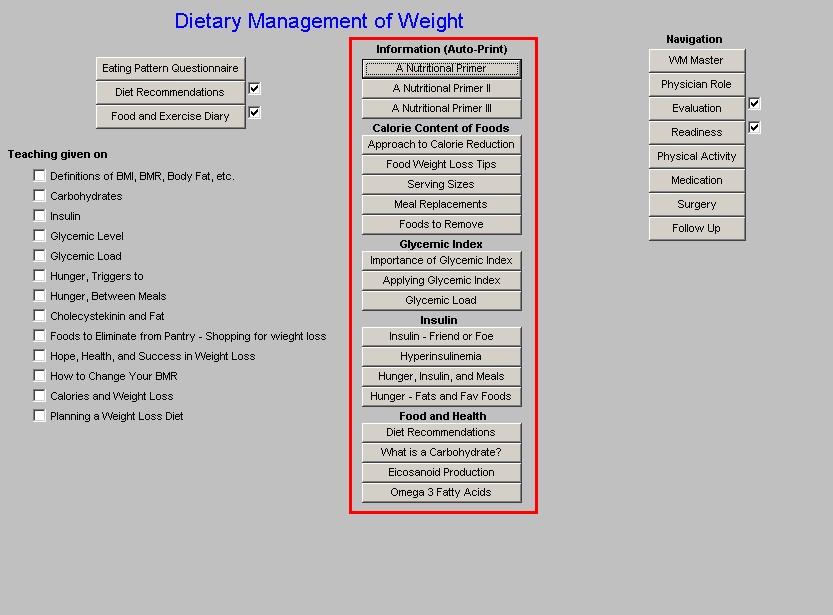
Column 3 –
Navigation Buttons

Physical Activity Template
Column 1
- What is Physical Activity? -- this button launches a document which states in part, “Physical activity can take place in a variety of occupational, household, and leisure-time situations. It is beneficial for weight management and when performed at a moderate intensity it is associated with other significant health-related benefits.”
- Exercise Template – this is a link to the Exercise Prescription. For details on how to use this template, see the Exercise Prescription tutor. If the patient has diabetes, the Diabetes Exercise template would be more appropriate for their use. For details on how to use this template, see the Diabetes Exercise tutor. If the patient has CHF, the CHF Exercise Template would be more appropriate. For details on how to use this template, see the CHF Exercise tutor.
- Physical Activity Quiz – this launches a Physical Activity Questionnaire which can be printed and given to the patient for completion. The information can then be entered into the EMR.
- Monitoring Recommendations – this launches a pop-up which has three recommendations with details on each; they are: Encourage your patient to maintain a physical activity calendar; Recommend the use of a step counter; Encourage your patient to monitor the intensity of their exercise.
- Barriers to Physical Activity – this allows you to document the reasons from most significant to least significant, as to why the patient does not consistently exercise.
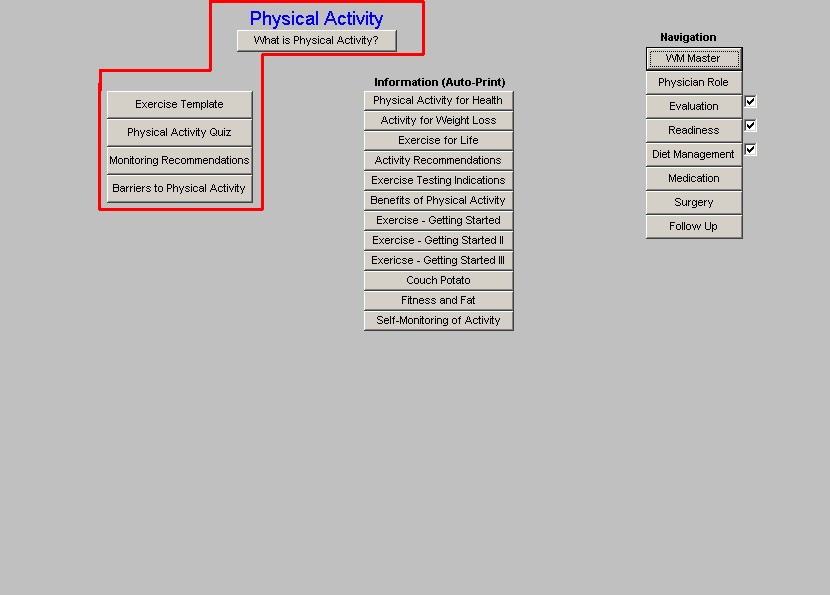
Column 2
The following educational documents are available for printing and giving to the patient:
- Physical Activity for health
- Activity for weight loss
- Exercise for life
- Activity Recommendations
- Exercise Testing indications
- Benefits of physical Activity
- Exercise Getting Stated I, II, III
- Couch Potato
- Fitness and Fat
- Self-monitoring of activity
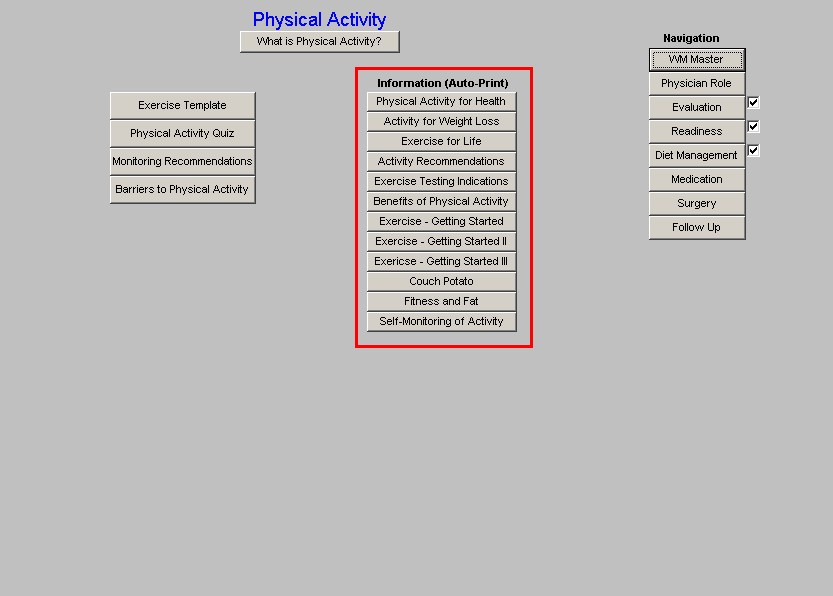
Column 3 –
Navigation
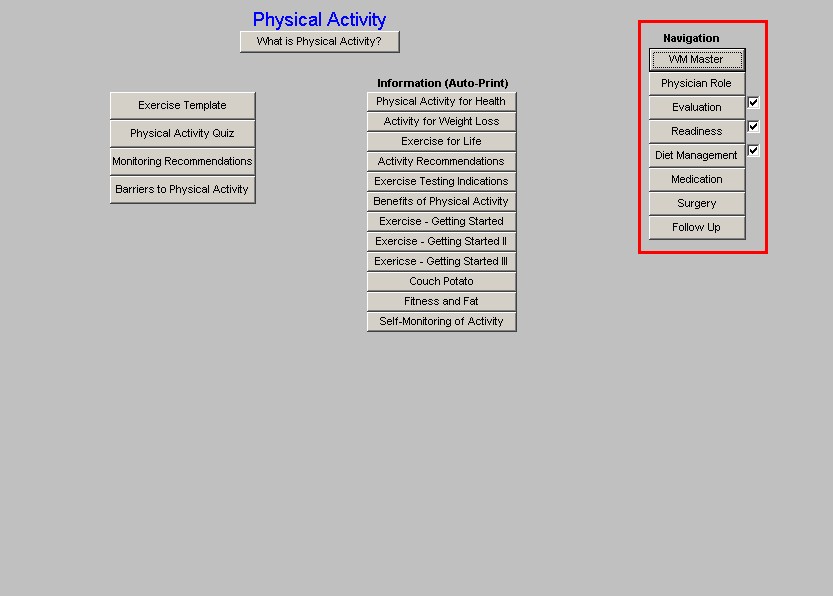
Medication Template
The full title of this template is: Medication Management of Weight Loss, which is organized into three columns
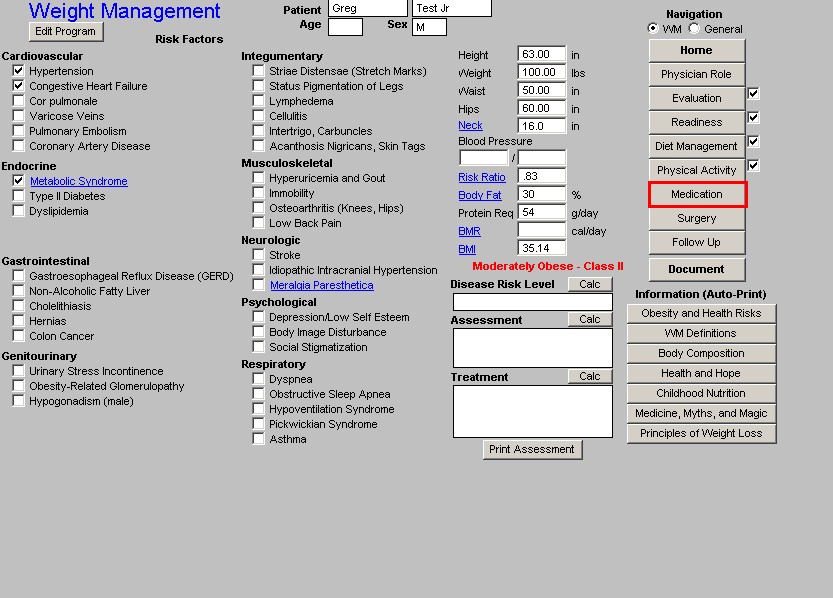
Column 1 is a list of check boxes which allow you to determine:
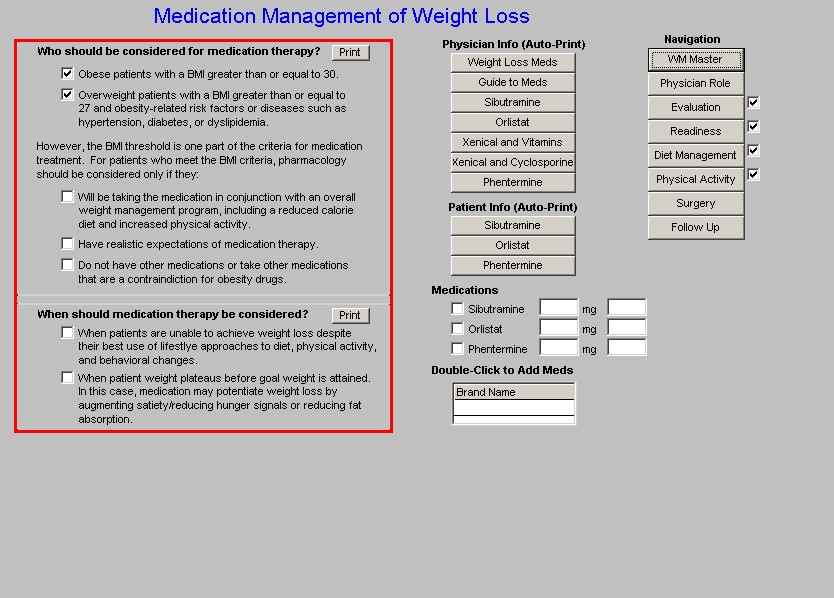
Column 2 –
Physician Information (auto-printed) – these are documents and/or tables which give information about weight loss medications and their appropriate use.
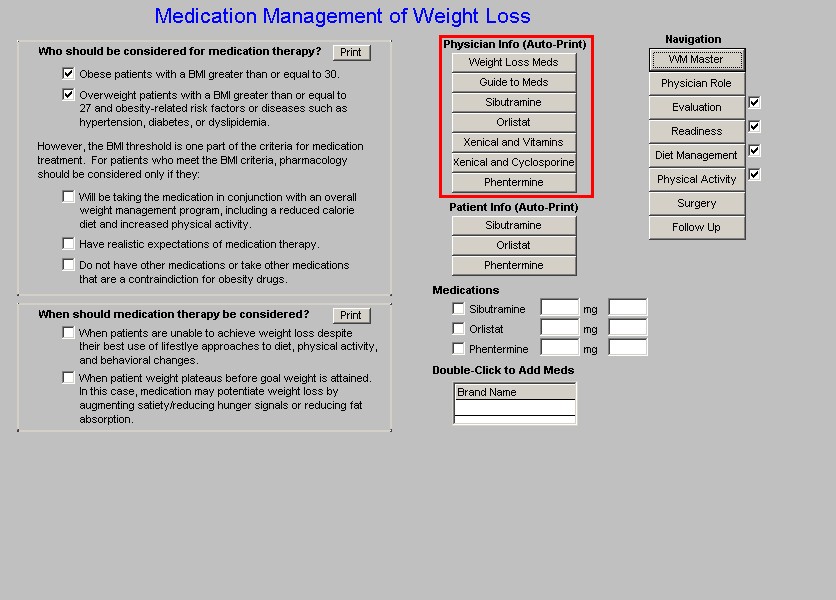
Patient information (auto-printed) – when a drug has been ordered per the function below this one, the accessing of the same medication in the patient information function, creates a document which includes the name of the medication, the dosage and instructions for use.
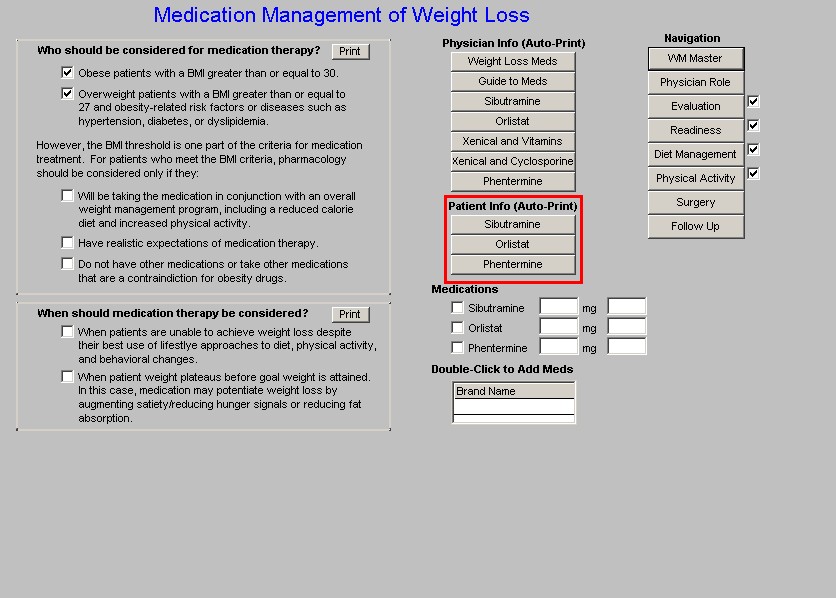
Medications – this is a function which allows you to indicate the name and dosage of the weight management drug you intend to use.
- Sibutramine
- Orlistat
- Phentermine
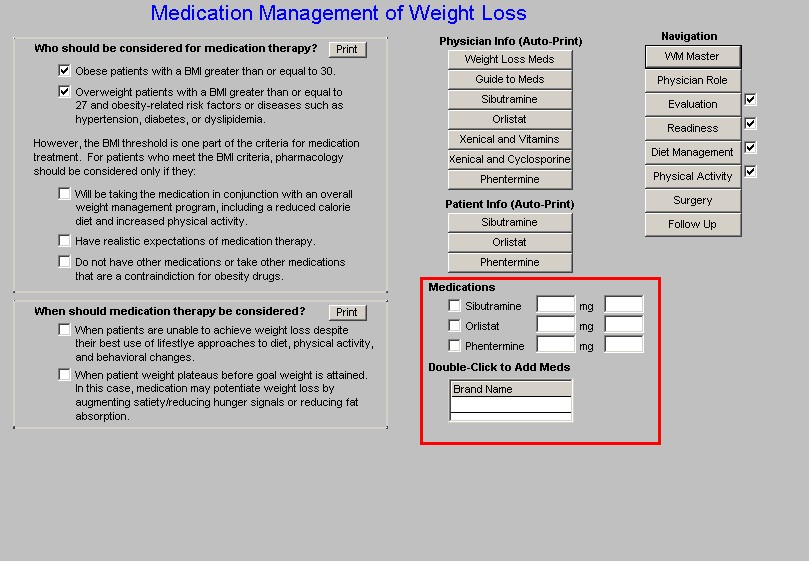
When the box beside Sibutramine is clicked, indicating that you intend to order this medication, the following pop-up appears:

If any of these are NOT checked, the note appears at the bottom which states in green, “Sibutramine is an acceptable drug for this patient.”

If any of these are checked, the note appears at the bottom which states in red, “Sibutramine is NOT an acceptable drug for this patient.”
When the box beside Orlistat is clicked indicating that you intend to order this drug, the following pop-up appears:
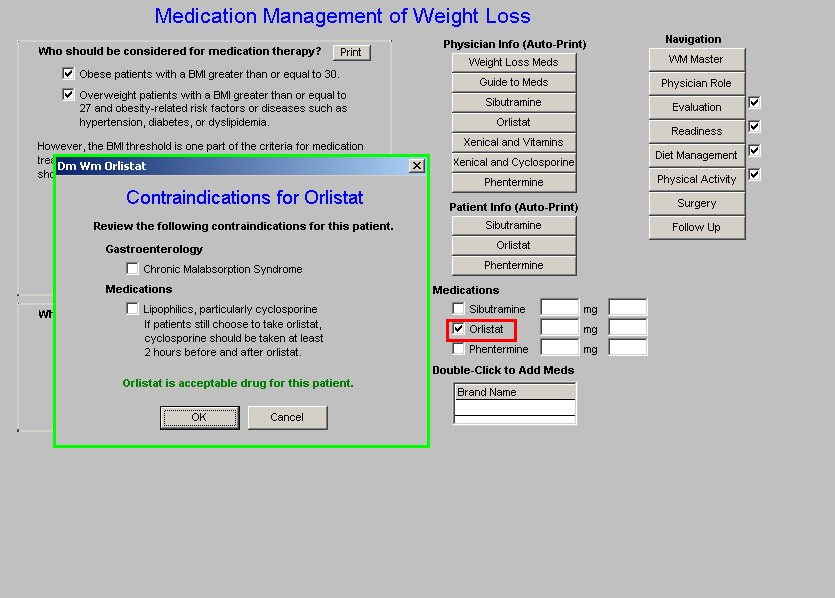
If neither of these is checked, the following statement appears in green, “Orlistat is acceptable drug for this patient.”
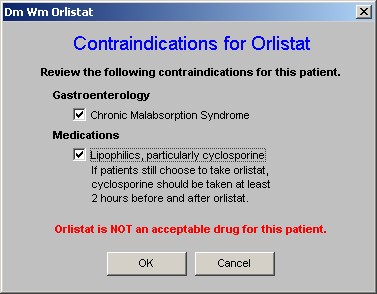
If either of these is checked, the following statement appears in red, “Orlistat is NOT acceptable drug for this patient.”

If the box beside Phentermine is checked the following pop-up appears:
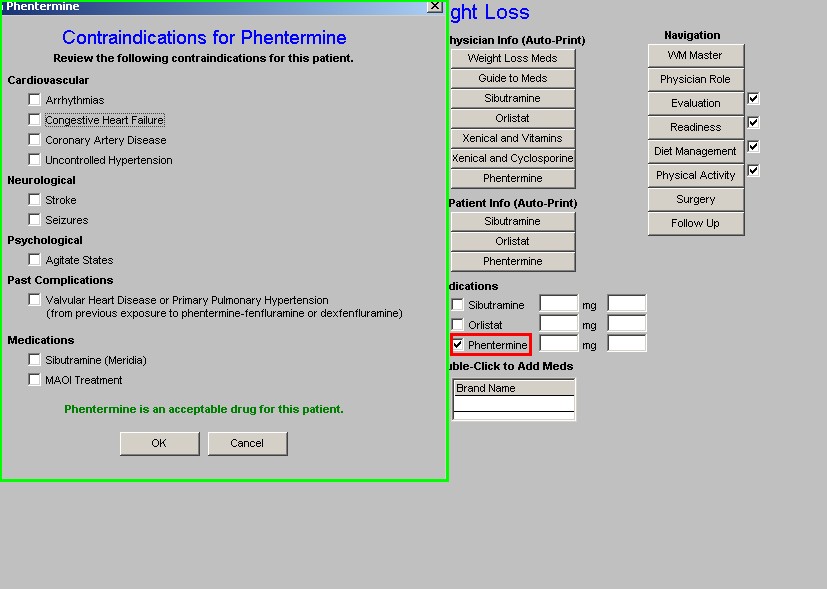
If any one of these is NOT checked the following appears in green “Phentermine is an acceptable drug for this patient.”
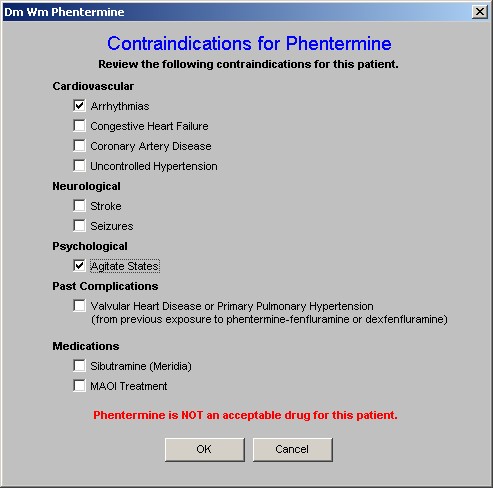
If any one of these is checked the following appears in red “Phentermine is NOT an acceptable drug for this patient.”
At the bottom of the template, there is a link to the medication module with the instruction, “Double click to add meds.”
Surgery Template
The full title of this template is Surgical Management of Obesity
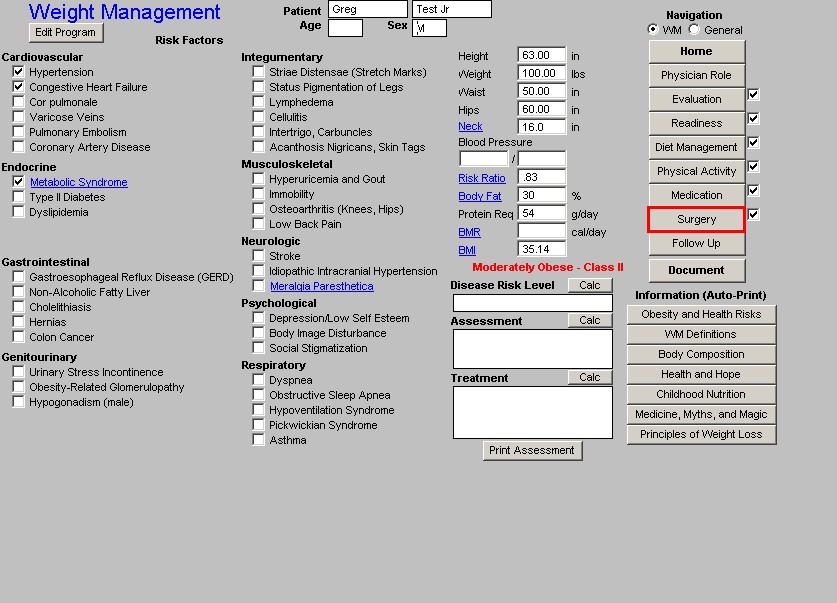
When should surgery be considered for weight management?
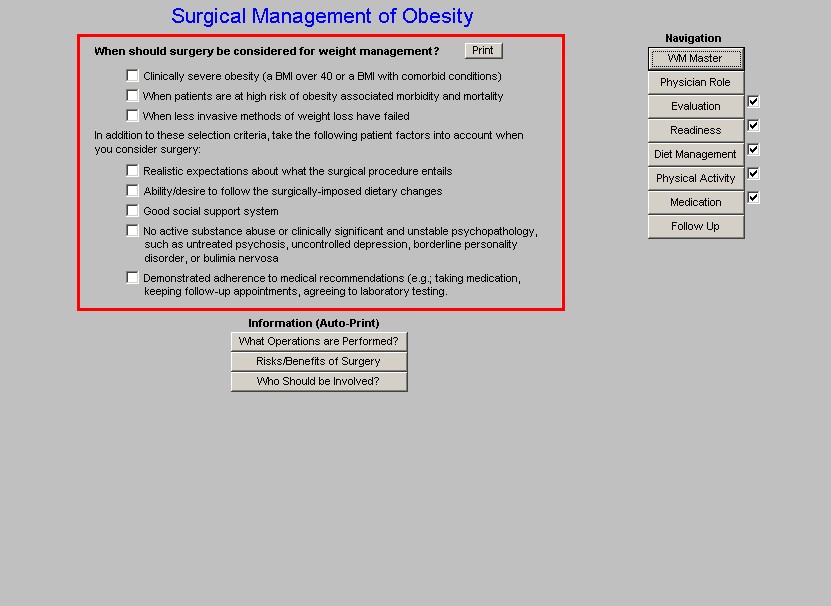
At the bottom of the template are three buttons under the heading, “Information (auto-Print):
- What Operations are Performed?
- Risks/Benefits of Surgery
- Who Should be Involved?

Right Hand Column
Navigation Buttons
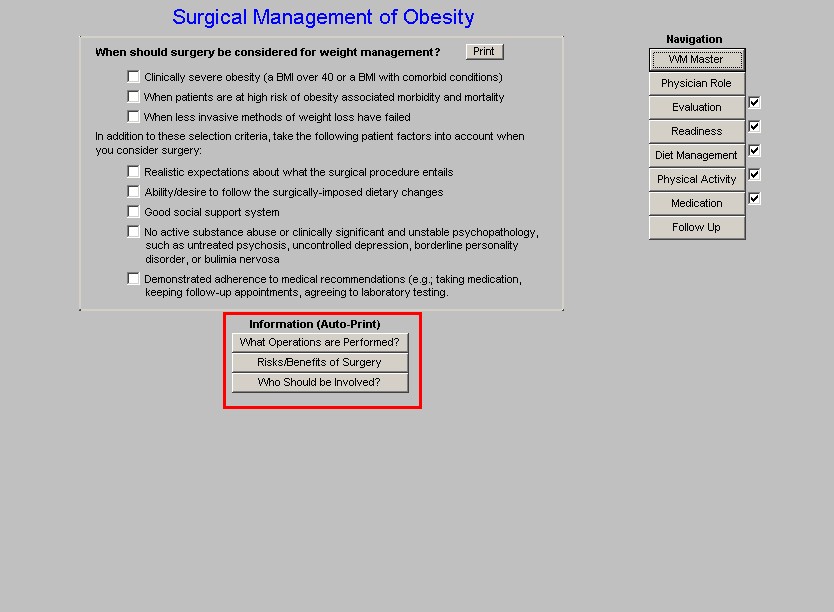

Follow-up Template
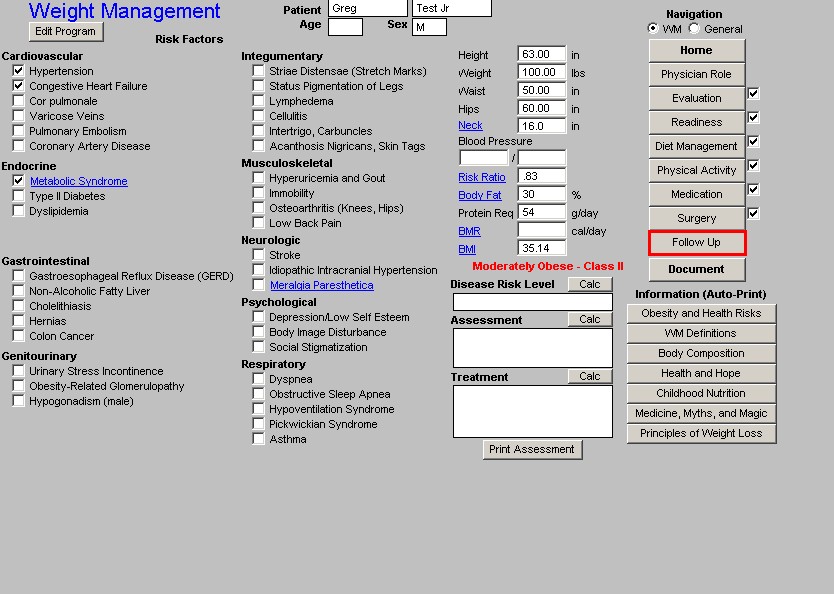
At the top of the template is a button entitled, What To Do At Follow-up Visits.
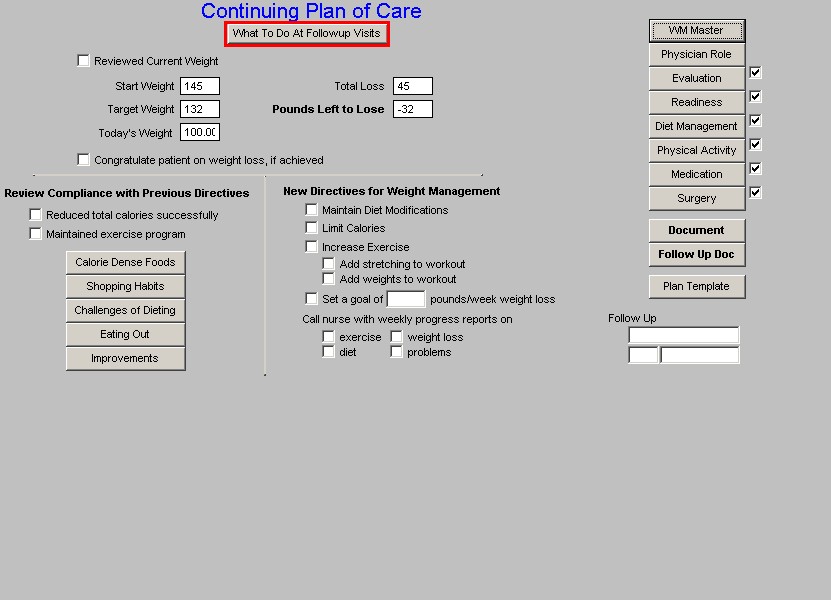
When it is depressed, the following instructions appear:
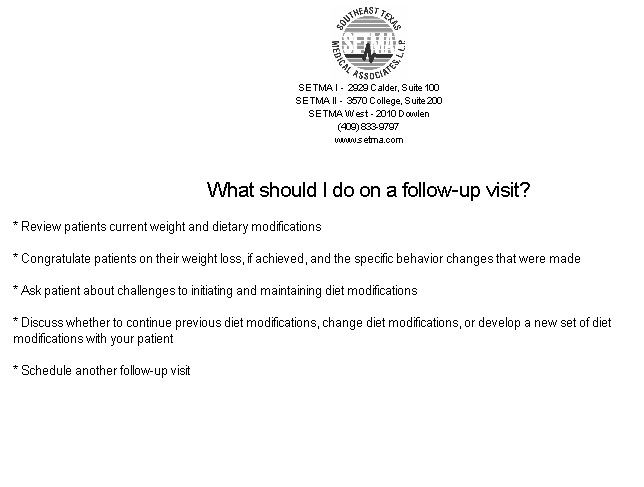
Reviewed Current Weight – there are three weights display here:
- Start Weight
- Target Weight
- Today’s Weight
Beside these three weights there are two boxes which display:
- Total loss – this is the total loss since the Start Weight was recorded at the first use of this suite of templates.
- Pounds to lose – this is the weight yet to be lost in order to eliminate weight as a health hazard.
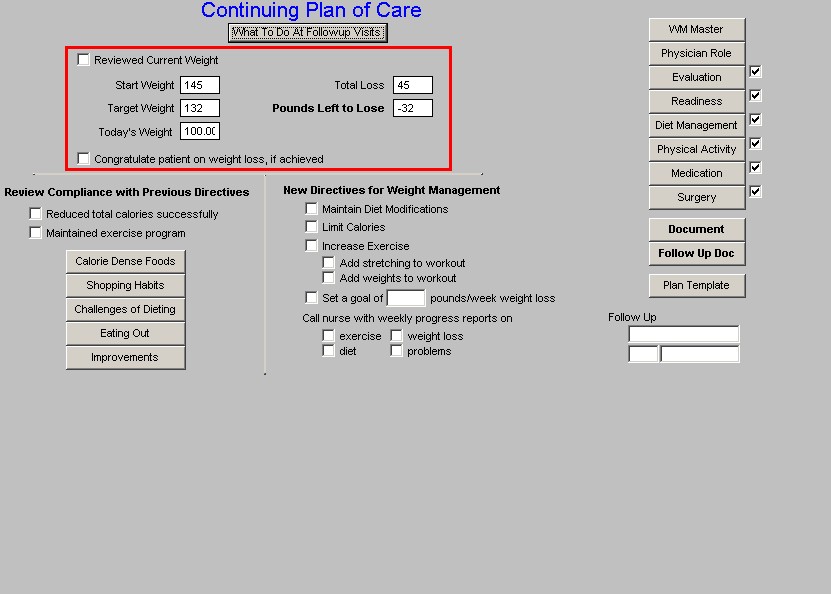
Congratulate Patient on weight loss, if achieved.
Review Compliance with Previous Directives
- Reduced Total Calories successfully
- Maintained exercise program
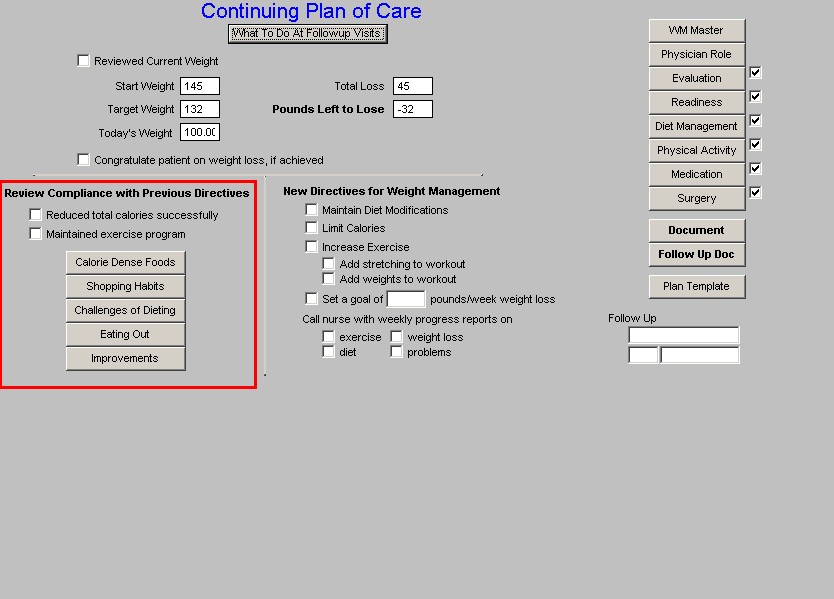
Beneath this are four buttons which launch lists of dietary weight loss recommendations which will be printed on the chart note automatically. These are auto checked when accessed:
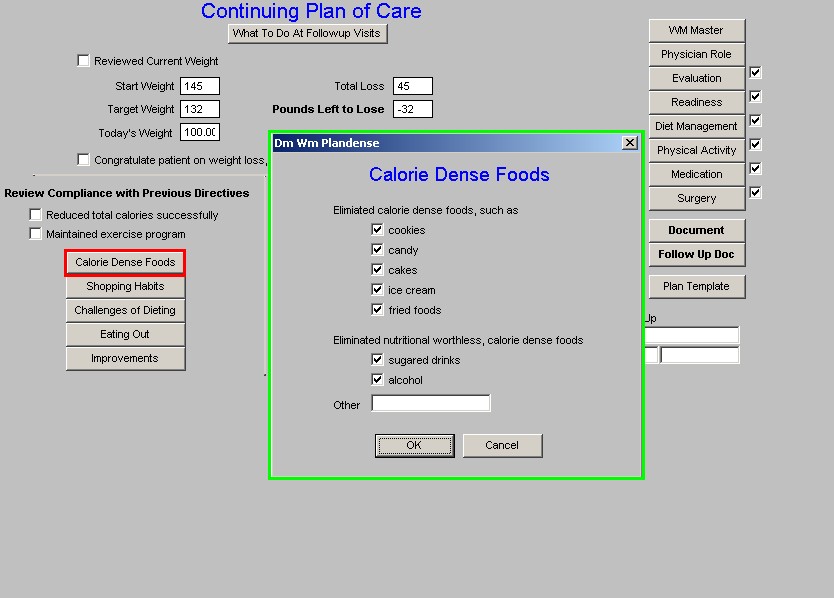
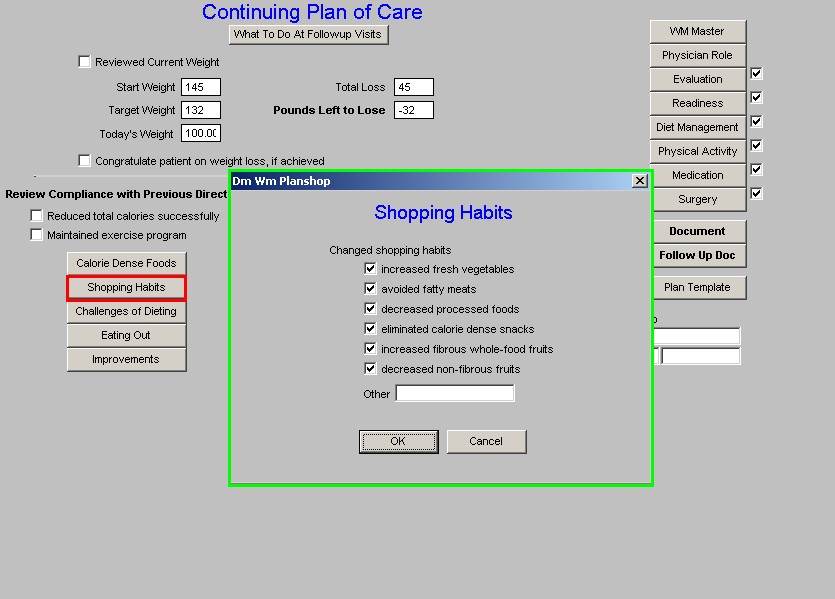
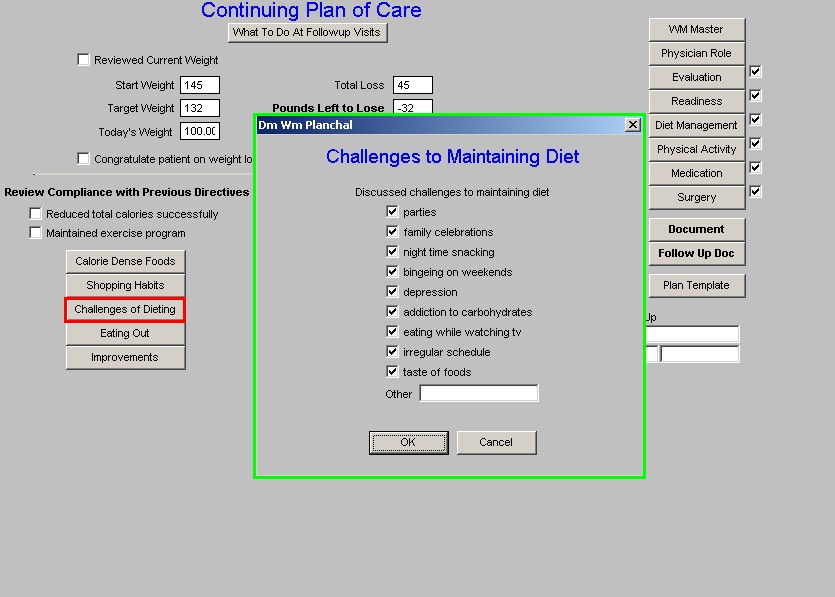
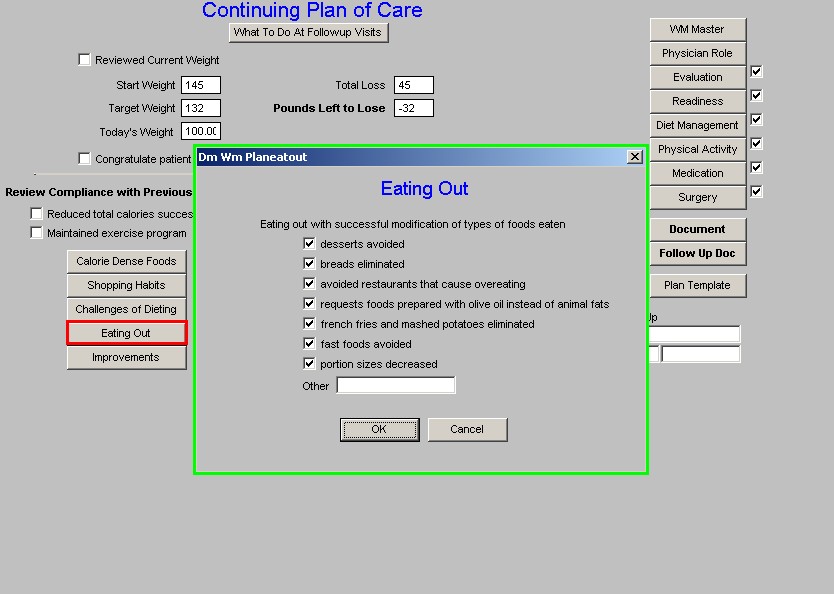
There is then a list of seven potential benefits of weight loss to review with the patient under the pop-up entitled Improvement:
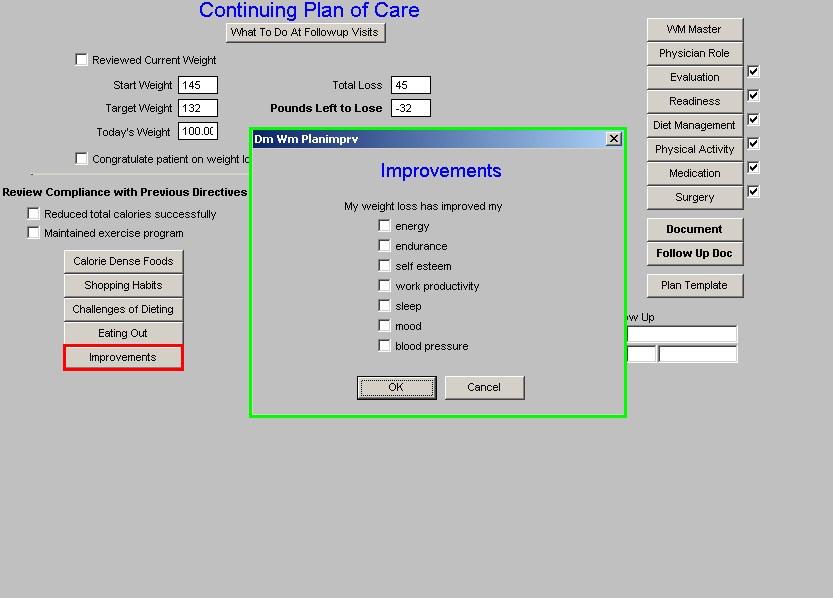
New Directives for Weight Management – this gives follow-up instructions to the patient and these appear on the follow-up note which is to be given to the patient:
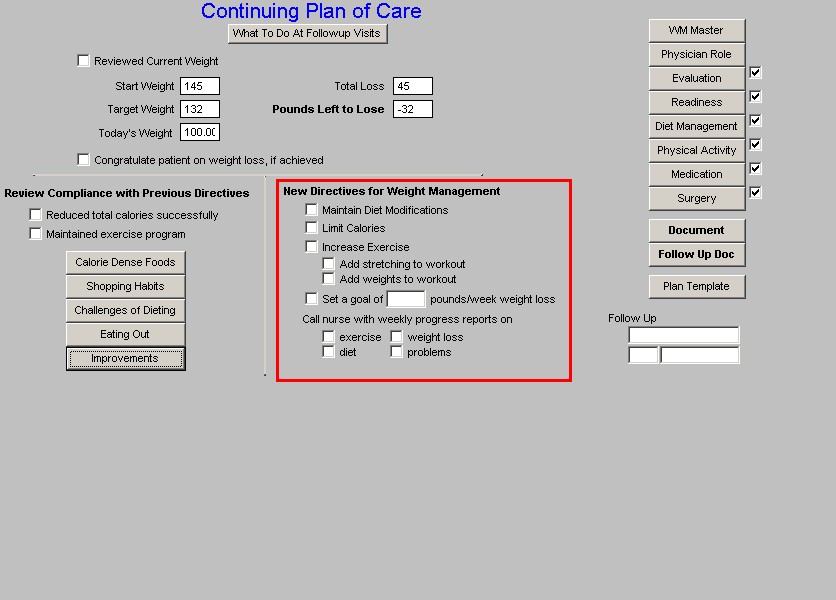
Right hand column
Navigation buttons
Follow-up Doc – this button launches the generation of the document which is to be given to the patient following a weight-management assessment.
Plan Template – this navigates you to the Master GP Plan Template for the completion of a visit which is focused completely on weight management. For information on using this template, see the Master GP tutor.
Follow-up – this enables the provider to schedule a follow-up weight management visit.
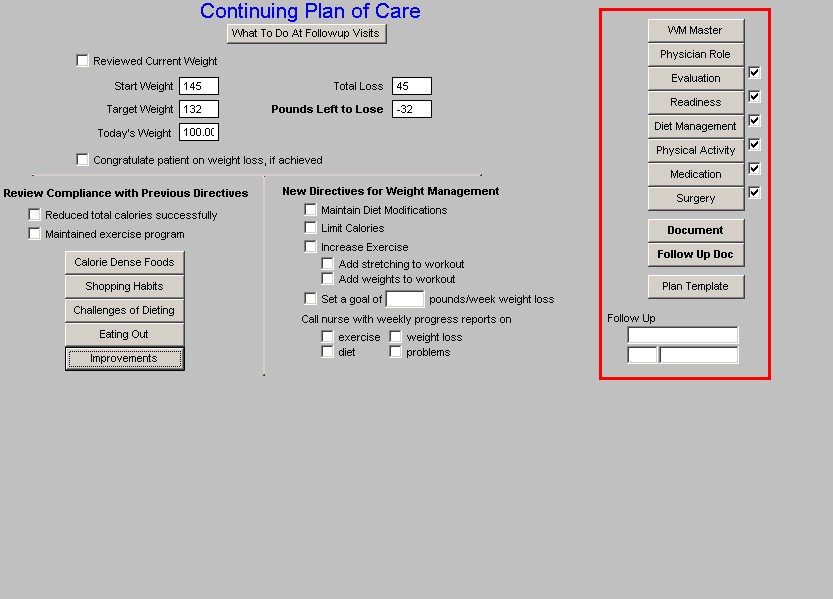
|